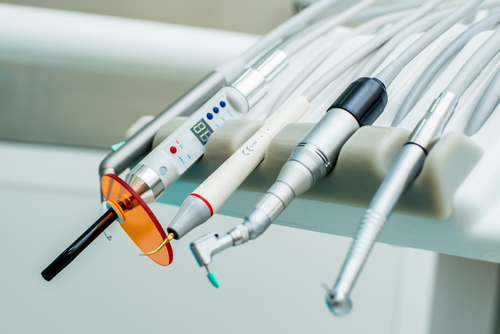Many people associate dental visits with feelings of fear. Indeed, most dislike the thought of a dentist prodding their teeth and gums with a variety of frightening tools. While it is natural to feel this way, there is no need for fear. Dentists are highly trained professionals who have spent years working with a wide range of dental tools to clean and treat the mouth. Still nervous? You may be able to take some comfort in understanding some common dental instruments and their specific applications. Remember, that is all they all are — tools for cleaning and treating your teeth and gums, wielded by experienced, careful hands.
Mouth Mirror
Most dental visits begin with your dentist examining your mouth. For this, they will use the mouth mirror: a small circular mirror attached to the end of a slim handle. Mouth mirrors serve a straightforward purpose: they allow the dentist to view the entire mouth, especially hard to see areas of the teeth.. Dentists also use the mirrors to reflect light into a specific area where they are working. The mouth mirror could also be used to hold your cheeks, lips, or tongue in place.
The Dental Explorers
To explore, probe, and discover — these are the jobs of the dental explorers. These dental tools come in a diversity of sizes and shapes, but the most commonly recognized one is the “sickle” explorer. Often used in conjunction with the mouth mirror, the explorer is used to detect periodontal pockets and their depth, as well as to find dental caries.
Saliva Ejector
As your dentist examines and explores in and around your teeth, your mouth will began to salivate which, can interfere with your dentist’s work. At several points throughout the visit, he or she will likely place a tube in your mouth–the saliva ejector–and ask you to close your lips around it. As you hold your lips in place, all of the moisture and saliva in your mouth will vacuum out, leaving your teeth and gums dry and clean for your dentist.
The Dental Drill
Classically feared, the dental drill and its high pitched squeal strikes fear into the hearts of many patients. But once you understand what it is and what it actually does in the hands of your dentist, you will find that these instruments are not so frightening after all. Dental drills are comprised of two parts: the body of the drill, which supplies air and water to the second part: the head, which revolves the drill bit at high speeds. Why the high speed? Dentists are using the drill to cut through (or, in some procedures, clean and polish) one of the hardest substances in the human body, enamel. Remember, this is all painless, as dentists provide an anesthetic to complete negate the side effects.
The next time you visit the dentist, remember that the instruments are only tools–tools wielded by professionals. And at Greenspoint Dental, our professionals are dedicated to giving you a bright smile without the pain or anxiety. For more information, contact our Houston office today!

